QUESTIONS
SECTION A (30 MARKS)
- Name two dual purpose sheep breed
- State two importance of livestock
- Name two methods used in selection of livestock
- Define the term breech presentation as used in livestock breeding
- State two disadvantages of embryo transplant
- State four factors that may predispose an animal to certain diseases.
- State four effects of parasites on livestock
- State two mechanical methods of controlling ticks in livestock
- Name two livestock diseases that are caused by bacteria
- State four methods of maintaining good health in livestock
- State two chemical methods of controlling bloat
- Name two sources of water in the body of ati animal
- State two functions of reticulum
-
- Name the part of the digestive system of a non-ruminant animal where cellulose is broken down
- Name the part of the digestive system of poultry where insoluble grit is found
- State the use of insoluble grit in the digestive system of poultry
- State two reasons for docking sheep
- Differentiate between live virulent vaccines and live attenuated vaccine
- Give four ways of stimulating milk let down in dairy cow
- Name two lubricant used in a tractor engine
- List two disadvantages of animal drawn implements
- State four maintenance practices carried out on a tractor battery
- State foui- reasons for proper care and maintenance of farm tools and equipment
- State two field conditions under which a fork jembe would be more suitable for use than a jembe
- State two disadvantages of a plunge dip
SECTION B (20 marks)
- Diagrams A and B below shows farm implements
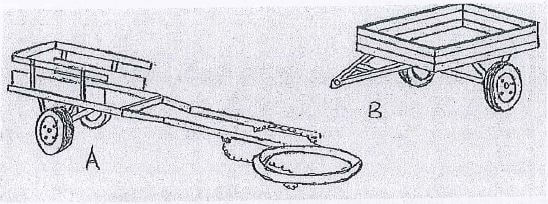
- Give the source of power used in operating each of the implements
- State the means by which each of the above implements is attached to its source of power.
- Give four advantages of iinplements A over implements B
- State four maintenance practices for implement A.
- Below is a list of livestock feeds
E................................. Dry roughage
F................................. Dairy meal
O................................. Maize meal
H................................. Fish meal-
- Classify the feed stuffs according to their nutritive value
E.............................
F.............................
G............................. - Why would cattle benefit more than pigs when fed on dry maize stalks
- State two ways of increasing cattle intalre of the feed labeled E
- Classify the feed stuffs according to their nutritive value
- If the feed H contains 7% digestible crude proteins (D.E.P) and C contains 62%DCP. Calculate the amount of each feedstuff in lcilogrammes required to prepare 200kg of chick mash containing 20% DCP ( use the pearson square method)
-
- The illustrations below shows some fann tools. Study them and answer the questions that follow
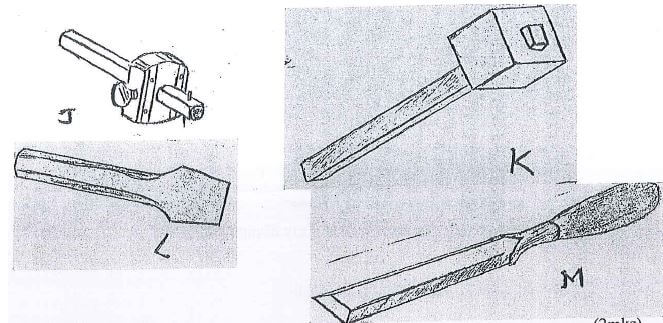
- Identify the tools
J.............................
K.............................
L.............................
M............................. - Name a tool that would be needed to be able to use the tool labeled L
- State two recommended maintenance practices that each of the tools labeled L and M may. Require after a period of use
M.............................
L.............................
- Identify the tools
- The illustrations P below show a method of identifying pigs. Stiidy the diagi‘am and answer the questions that follow
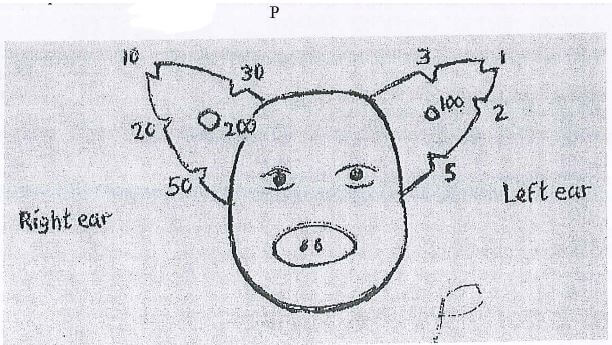
One the diagram Q pi’ovided below draw notch marks to indicate a pig number’ 168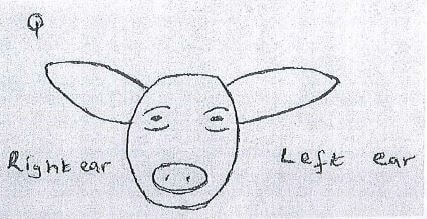
- On the above diagram show the identity of pig number 108
- Give four other methods of identification
SECTION C. (40 MARKS)
Answer any two questions in this section in the spaces provided at the end of the section.
-
- State the functions of the following parts of a mouldboard plough
- Beam
- Share
- mould board
- Disc coulter
- Landside
- Depth Wheel
- State the operational differences between a mouldboard and a disc plough (5mks)
- Describe five advantages of a live fence (5 mks)
- State the functions of the following parts of a mouldboard plough
-
- Describe the artificial rearing of layer chicks fi'oln day old upto the end of brooding (8mks)
- Describe the characteristics of a poor layer, which should be considered during culling (6mks)
- Describe the life cycle of three host tick (6mks)
-
- Describe the procedure followed when constructing a barbed wire fence (8mks)
- Describe the control measures of diseases in livestock (7mks)
- Outline the differences between a petrol engine and a diesel engine (5mks)
MARKING SCHEME
- Two dual purpose sheep
- Romney marsh
- Corriedale
- Hampshire down
- Importance of livestock
- Source of food
- Source of income
- Cultural value
- Animal power
- Provision of raw materials
- Methods used in selection of livestock
- Mass selection
- Progeny testing
- Contemporary comparison
- Breech presentation is where hind legs coming out first during parturition
- Disadvantages of embryo transplant
- Expensive
- Requires trained personal to handle and administer
- Requires special equipment for fertilization and storage of the embryos
- Factors predisposing an animal to diseases
- Species
- Breed
- Age
- Sex
- Colour of the animal
- Four effects of parasites on livestock
- Causes aneamia
- Deprive host of food
- Injury and damage to tissue and organs
- Disease transmission
- Cause irritation
- Obstruction to internal organs
- Two mechanical methods of controlling ticks in livestock
- Burning the infested pastures
- Interfering with or altering the ticks environment
- Fencing off pasture land
- Starving ticks/hand picking
- Livestock diseases caused by bacteria
- Mastitis
- Black quarter
- Foot-rot
- Contagious abortion
- Anthrax
- Pneumonia
- Scours
- Four methods of maintaining good health in livestock
- Proper sanitation
- Regular vaccination
- Proper housing
- Isolation of sick animal
- Timely treatment of sick animals
- Proper breeding and selection
- Control of vectors/dipping/spraying
- Control of internal parasites/deworming
- Imposing quarantine
- Proper feeding/nutrition
- Two chemical methods of controlling bloat
- Drenching using suitable oils
- Administering Epsom salt
- Administering methyl silicone as directly into the rumen
- Two sources of water in the e body of an animal
- Free water/ drinking
- From food/bound water
- From metabolism / metabolic water
- Two functions of reticulum
- Sieving and separating fine from course food materials
- Retaining foreign and indigestible materials such as polythene paper etc.
-
- = Ca ecum
- Gizzard
- Helps in digestion/grinding food particles
- Two reasons for docking sheep
- Facilitate tuping/mating
- Fat distribution
- Prevent blowfly infestation
-
- Live virulent vaccine - living organisms capable of causing disease to an animals
- Live attenuated vaccine - disease causing organism whose ability to cause the disease has been reduced. (mark as a whole)
- Four ways of stimulating milk let-down in a daily cow
- Feeding
- Sounds associated with milking
- Milkman/milking parlour
- Washing/massaging udder
- Two lubricants
- Oil
- Grease
- Disadvantages of animal drawn implements
- Slower than tractors
- Provide shallow cultivation
- Less durable compared to tractor drawn
- Maintenance practices carried out on a tractor battery
- Level of electrolyte should be maintained
- Corroded terminal should be cleaned and smeared with grease
- Battery should be tightly fixed to avoid spillages
- Should be fitted correctly on the tractor
- Should be charged regularly or periodically
- Battery content should be emptied incase of long storage
- Fan belt tension should be adjusted accordingly
- Reasons for proper care and maintenance of farm tools and equipments
- Increase durability
- Reduce replacement cost
- Increases efficiency
- To avoid injury to users
- To avoid damage to the tool
-
- Field with wet and sticky soils
- Field with Rhizomes
- Rocky field
- Hard soils
- Two disadvantages of a plunge dip
- High initial capital
- Intensive labour during construction
- Dip wash strength is difficult to maintain
- Diseases such as foot and mouth can be introduced into dip wash
-
-
- A- Animal power
- B- Tractor
-
- A- Harness
- B-Drawbar
-
- It is cheaper
- It is easier to maneuver with the farm
- Source of power is locally available
- It is cheaper to maintain the equipment
- It requires less power
- its lighter than B
- Check the tyre pressure
- Grease moving parts
- Tighten loose nuts and bolts
- Repair/replace broken parts
- Clean implements after use
- Keep implement under shed
-
-
-
- E Dry roughage( reject, roughage alone or sacculent roughage)
- G Carbohydrate/energy concentrate
- H Protein concentrate
- Cattle are ruminants hence are able to digest cellulose using microorganism in their rumen while pigs are monogastric and cannot be able to digest cellulose
- Use of various additives e.g molasses or salt or morasses - urea mixture; MUM
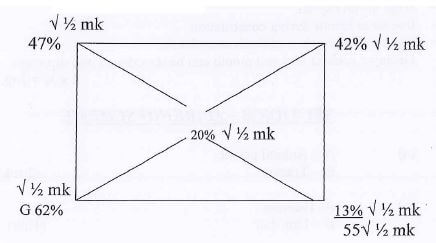
For H-42/55 x 200 = 152.7 kg fishmeal
For G= 13/55 x 200 = 47.3 kg maize meal
-
-
- J-marking gauge
K- Mallet
L-cold chisel
M-Wood chisel - Ball pein hammer
- L-Sharpening
Canning the mushroom head
M-sharpening
Removing the mushroom in head
- J-marking gauge
-
-
- Beams
- Provides surface for attachment of the other parts of the plough
- Adds Weight to the plough for better penetration (2mks)
- Share
- cuts the furrow slice horizontally
- Initiates lifting of the furrow slice
- Moldboard
- Inverts the furrow slice
- Disc coulter
- Cuts furrow slice vertically separating it from the unploughed land
- Cuts trash /vegetation
- Landside
- Counteracts side pressure thrust created by the furrow slices on the mouldboard and share
- Makes the plough steady/stabilizes the plough
- Depth wheel
- It controls the depth of ploughing
- Beams
-
Moulboard Plough Disc Plough cannot be used on fields with obstacles because it is rigid and slides along in operation can be used on fields with obstacles because of the rolling action of the disc inverts furrow slices completely does not invert furrow slices completely fewer secondary operations are needed after using the plough more secondary operations are needed after using the plough operations on uniform depth operations at varying depthsdue to its rolling action easily broken by obstacles not easily broken by obstacles because it rides over them requires more power to pull when operating requires less power to pull when operating -
petrol engine diesel engine it has a carburetor it has an injector pump fuel and air are mixed in the carburetor before it gets into the engine the fuel an air are mixed within the cylinder fuel is ignited by an electric spark fuel is ignited by compression of air and fuel mixture in the cylinder it produces little smoke because petrol is completely burnt produces a lot of smoke since the diesel is not completely burnt petrol engine is light in weight and suited for light duties it is relatively heavy in weight and suited to heavy duties
-
-
-
- Ensure brooder corners are rounded
- Provide enough brooding space according to the number and age of the chicks
- Clean and disinfect the brooder/brooder house/equipment i.e. waters/feeder
- Provide proper litter n the floor/wood shavings
- Maintain appropriate range of temp according to the age of the chicks
- Temp. during the first week should be 32-35.c then reduce accordingly
- Maintain proper ventilation by adjusting the openings
- Provide fresh, adequate and quality feed/chick mash
- Provide brooder with reliable and appropriate lighting/dim light to avoid cannibalism.
- Provide adequate and appropriate waters according to the age/provide feeders
- Control parasites by applying appropriate pesticides
- Control diseases using appropriate methods e.g. vaccination/prophylactic drugs
- Isolate and treat the sick chicks immediately
- Keep proper records
- Debeaking should be done 8-10 days towards the end of brooding
- Provide adequate clean water all the time
- Provide adequate clean water all the time
- Spread sheets of paper on litter and spread feeds on them
- Remove dead chicks
- Gradual change of feeding in the last one week
- Provide wire guard around the source of heat.
(Award one mark each for any correct 14)
-
- Combs and wattles are small, dry and cold
- Vent is small, round, dry and pigmented/yellow pigment
- The spaces between pelvic bones is narrow/2-3 fingers cannot fit in the space between the pelvic bones
- Plumage is usually shiny, well preened and sometimes moulting
- Yellowish pigmentation is common in the vent, beak and shank
- Space between the keel bone and pelvic bone is small /3-4 fingers cannot fit
- Eyes dull and pale /yellow
- Abdomen is hard
- The layer is lazy and dull
- Hens becomes broody
(Award one mark each for any correct 6)
-
-
- Procedure followed when constructing a barbed wire fence
- Clear the fence line
- Measure and mark the position of the holes with pegs
- Dig holes for the posts- 4-6m apart and 60cm deep
- Fix the posts in the holes using concrete mixture/firm the soil around the base of the post
- Fix the lowest strand of wire about 25cm from the ground level
- Stretch the wire with wire strainer and then nail it with fencing staples
- Use the first strand of wire to guide in fixing the rest of the wires until four strands of wire are fixed.
- Fix the droppers in position
Mark procedurally 1x 8=(8mks)
-
- Use of prophylactic drugs
- Use of antiseptics and disinfectants
- Quarantine
- Isolation
- Mass slaughter/culling
- Vaccination
- Control of vectors
- Use of healthy breeding stock/Artificial insemination
- Proper nutrition
- Treating sick animals
- Drenching/control of internal parasites
- Keeping resistant type of animals
- Feed animals with dry roughages before feeding them on succulent roughages
- Hoof trimming
- Proper housing
(12 x 1 = 12 mks)
- Procedure followed when constructing a barbed wire fence
Download Agriculture Paper 2 Questions and Answers - Mangu High School Mock Exams 2022.
Tap Here to Download for 50/-
Get on WhatsApp for 50/-
Why download?
- ✔ To read offline at any time.
- ✔ To Print at your convenience
- ✔ Share Easily with Friends / Students
